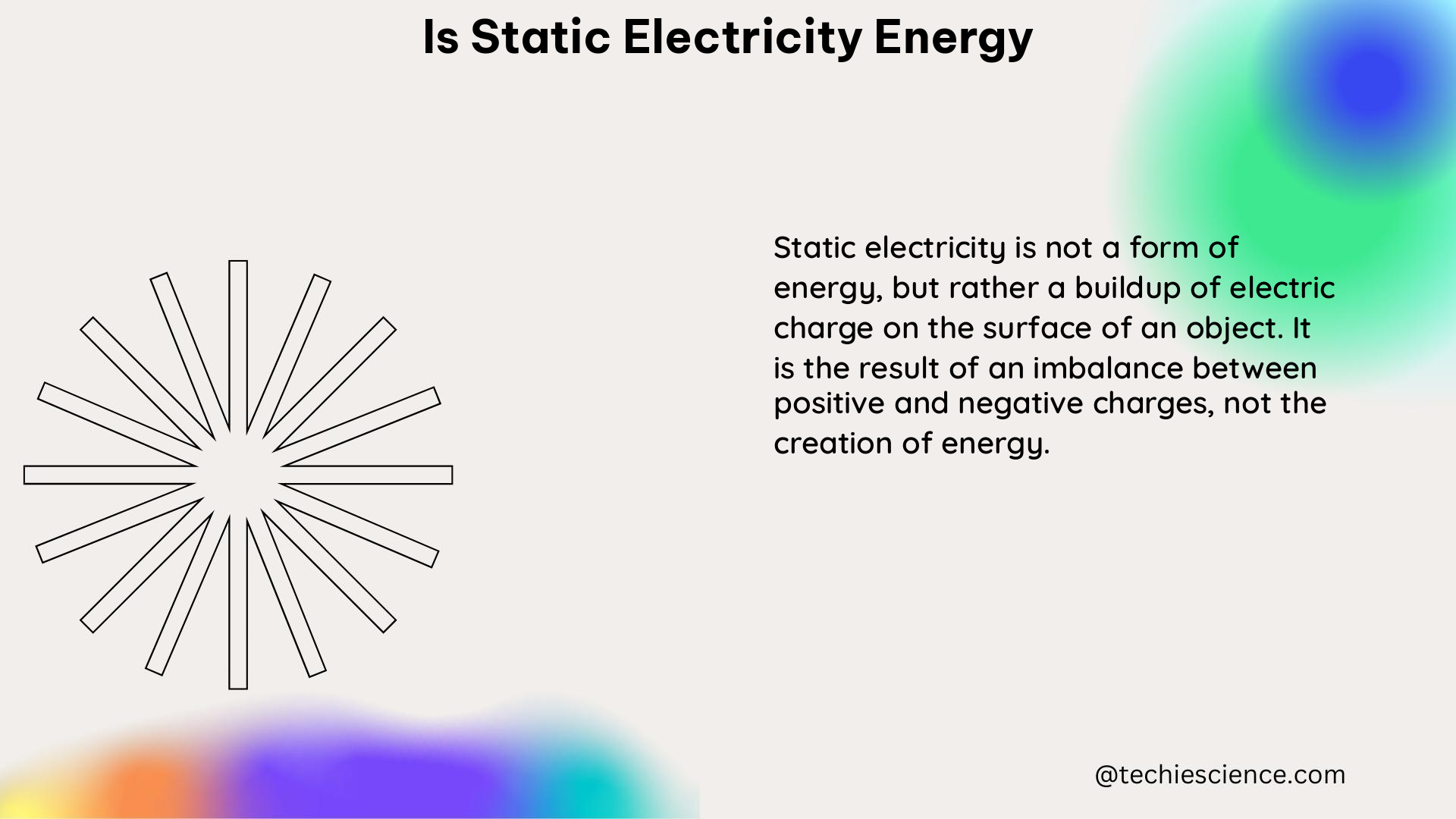Static electricity is a fascinating phenomenon that has intrigued scientists and engineers for centuries. It is a form of electrical charge that builds up on the surface of an object, often due to the transfer of electrons between materials through friction or contact. While static electricity is not a form of energy in the traditional sense, it does possess unique properties that make it an important consideration in various applications.
Understanding Static Electricity
Static electricity is the result of an imbalance of electric charges within or on the surface of a material. This imbalance can be caused by several factors, including:
- Friction: When two materials are rubbed together, electrons can be transferred from one surface to the other, creating a static charge.
- Induction: When a charged object is brought near a neutral object, the neutral object can become polarized, with one side having a positive charge and the other a negative charge.
- Separation of materials: When two materials are pulled apart, the separation can result in one material gaining electrons and the other losing them, creating a static charge.
The measurement of static electricity is crucial as it allows for the determination of the presence, size, and location of the static charge. Static electricity is measured in Coulombs, which is the unit of electric charge. However, it is not possible to measure the charge in a material directly in Coulombs. Instead, the electric field strength or surface voltage related to the static charge is measured, which is the accepted method of measuring static in industry.
Measuring Static Electricity

The relationship between the electric field strength and voltage is that the former is the voltage gradient at any point. Measuring surface voltage is typically done using a Fraser 715 Static Meter, which measures the voltage across a capacitor that varies directly with the charge. The capacitance is set at a measuring distance of 100 mm, which means that the charge Q varies directly with the voltage V. Fraser meters are simple to use and very useful in analyzing problems. The 715 Static Meter is ideal for non-hazardous environments, while the EX-715, which is ATEX and IECEx certified, is safe for Zones 1 and 2 and can be used in EX hazardous areas.
Formulas and Calculations
The relationship between the electric field strength (E) and the voltage (V) is given by the formula:
E = -dV/dx
Where:
– E is the electric field strength (in V/m)
– V is the voltage (in V)
– x is the distance (in m)
The charge (Q) on a capacitor is related to the voltage (V) and the capacitance (C) by the formula:
Q = CV
Where:
– Q is the charge (in C)
– C is the capacitance (in F)
– V is the voltage (in V)
Examples and Numerical Problems
Example 1: A charged object has a surface voltage of 5 kV and is placed 10 cm (0.1 m) away from a neutral object. Calculate the electric field strength at the surface of the neutral object.
Given:
– Voltage (V) = 5 kV = 5000 V
– Distance (x) = 0.1 m
Using the formula: E = -dV/dx
E = -(5000 V) / (0.1 m)
E = -50,000 V/m
Therefore, the electric field strength at the surface of the neutral object is -50,000 V/m.
Example 2: A capacitor has a capacitance of 100 pF (1 × 10^-10 F) and is charged to a voltage of 1 kV (1000 V). Calculate the charge stored on the capacitor.
Given:
– Capacitance (C) = 100 pF = 1 × 10^-10 F
– Voltage (V) = 1 kV = 1000 V
Using the formula: Q = CV
Q = (1 × 10^-10 F) × (1000 V)
Q = 1 × 10^-7 C
Therefore, the charge stored on the capacitor is 1 × 10^-7 C.
Electric Fields and Static Electricity
Electric fields are regions of space in which electrical (Coulomb) forces act. Every charged object is surrounded by an electric field, and the field lines run perpendicular to the material and show the direction in which the force acts. The electric field can be coupled with other bodies with important consequences for measuring and neutralizing the charge.
When the charged material passes over a roller, the electric charge couples with the roller and seems to disappear, making it impossible to make an accurate measurement near the roller. The electric field ‘returns’ when the material leaves the roller and can be measured again.
Conclusion
While static electricity is not a form of energy in the traditional sense, it is a fascinating and important phenomenon with numerous applications in various fields, from electronics to industrial processes. Understanding the principles of static electricity, its measurement, and the role of electric fields is crucial for effectively managing and harnessing this unique form of electrical charge.
References:
– Primary Connections – Electrostatics
– VEX Forum – Static Electricity: Quantitative Measurement & Prevention
– Ferrovial – Static Electricity
– Fraser Antistatic – Measurement of Static Electricity
– Physics Forums – Can static electricity be measured and how dangerous can it be?
Hi…I am Ankita Biswas. I have done my B.Sc in physics Honours and my M.Sc in Electronics. Currently, I am working as a Physics teacher in a Higher Secondary School. I am very enthusiastic about the high-energy physics field. I love to write complicated physics concepts in understandable and simple words.